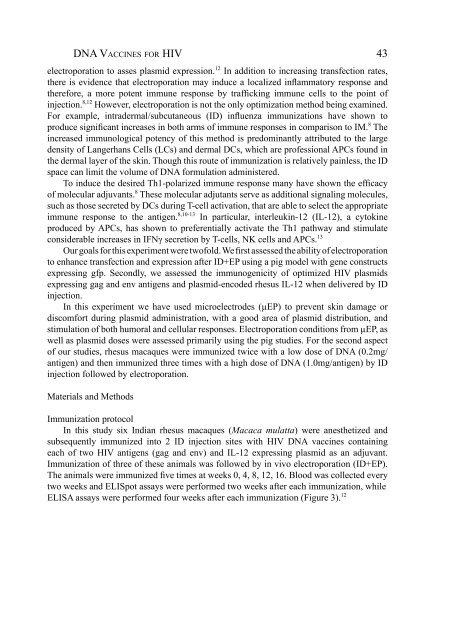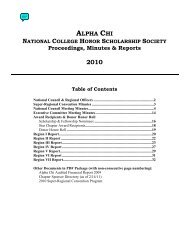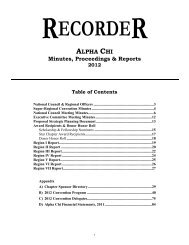Vol. 52, No. 1, 2009 - Alpha Chi
Vol. 52, No. 1, 2009 - Alpha Chi
Vol. 52, No. 1, 2009 - Alpha Chi
You also want an ePaper? Increase the reach of your titles
YUMPU automatically turns print PDFs into web optimized ePapers that Google loves.
DNA Va c c i n e s f o r HIV<br />
electroporation to asses plasmid expression. 12 In addition to increasing transfection rates,<br />
there is evidence that electroporation may induce a localized inflammatory response and<br />
therefore, a more potent immune response by trafficking immune cells to the point of<br />
injection. 8,12 However, electroporation is not the only optimization method being examined.<br />
For example, intradermal/subcutaneous (ID) influenza immunizations have shown to<br />
produce significant increases in both arms of immune responses in comparison to IM. 8 The<br />
increased immunological potency of this method is predominantly attributed to the large<br />
density of Langerhans Cells (LCs) and dermal DCs, which are professional APCs found in<br />
the dermal layer of the skin. Though this route of immunization is relatively painless, the ID<br />
space can limit the volume of DNA formulation administered.<br />
To induce the desired Th1-polarized immune response many have shown the efficacy<br />
of molecular adjuvants. 8 These molecular adjutants serve as additional signaling molecules,<br />
such as those secreted by DCs during T-cell activation, that are able to select the appropriate<br />
immune response to the antigen. 8,10-13 In particular, interleukin-12 (IL-12), a cytokine<br />
produced by APCs, has shown to preferentially activate the Th1 pathway and stimulate<br />
considerable increases in IFNγ secretion by T-cells, NK cells and APCs. 13<br />
Our goals for this experiment were twofold. We first assessed the ability of electroporation<br />
to enhance transfection and expression after ID+EP using a pig model with gene constructs<br />
expressing gfp. Secondly, we assessed the immunogenicity of optimized HIV plasmids<br />
expressing gag and env antigens and plasmid-encoded rhesus IL-12 when delivered by ID<br />
injection.<br />
In this experiment we have used microelectrodes (µEP) to prevent skin damage or<br />
discomfort during plasmid administration, with a good area of plasmid distribution, and<br />
stimulation of both humoral and cellular responses. Electroporation conditions from µEP, as<br />
well as plasmid doses were assessed primarily using the pig studies. For the second aspect<br />
of our studies, rhesus macaques were immunized twice with a low dose of DNA (0.2mg/<br />
antigen) and then immunized three times with a high dose of DNA (1.0mg/antigen) by ID<br />
injection followed by electroporation.<br />
Materials and Methods<br />
Immunization protocol<br />
In this study six Indian rhesus macaques (Macaca mulatta) were anesthetized and<br />
subsequently immunized into 2 ID injection sites with HIV DNA vaccines containing<br />
each of two HIV antigens (gag and env) and IL-12 expressing plasmid as an adjuvant.<br />
Immunization of three of these animals was followed by in vivo electroporation (ID+EP).<br />
The animals were immunized five times at weeks 0, 4, 8, 12, 16. Blood was collected every<br />
two weeks and ELISpot assays were performed two weeks after each immunization, while<br />
ELISA assays were performed four weeks after each immunization (Figure 3). 12<br />
43









